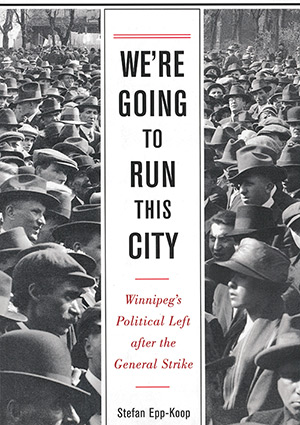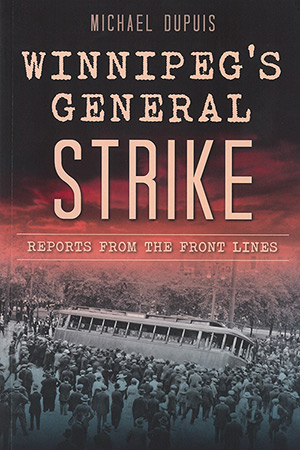by Greg Thomas
Winnipeg
|
Stefan Epp-Koop, We’re Going To Run This City, Winnipeg’s Political Left after the General Strike. Winnipeg: University of Manitoba Press, 2015, 197 pages. ISBN 978-0-8875-5784-2, $24.95 (paperback)
Michael Dupuis, Winnipeg’s General Strike, Reports from the Front Lines. Charleston, SC: The History Press, 2014, 141 pages. ISBN 978-1-6261-9339-0, $19.99 (paperback)
 Few events in Canadian history have attracted more attention from writers of various disciplines than the Winnipeg General Strike. With the recent publication of two more volumes associated with this nationally significant event by historians Stefan Epp-Koop and Michael Dupuis, one immediately speculates on what can possibly be added to the narrative and analysis surrounding the General Strike that gripped Winnipeg from 15 May to 26 June 1919. To the credit of both these historians, they have succeeded in providing well researched and accessible accounts that broaden our understanding of the Winnipeg General Strike, and in the case of Epp-Koop’s piece, provides a lucid treatment of how Winnipeg’s Political Left evolved in the twenty years after the end of the Strike.
Few events in Canadian history have attracted more attention from writers of various disciplines than the Winnipeg General Strike. With the recent publication of two more volumes associated with this nationally significant event by historians Stefan Epp-Koop and Michael Dupuis, one immediately speculates on what can possibly be added to the narrative and analysis surrounding the General Strike that gripped Winnipeg from 15 May to 26 June 1919. To the credit of both these historians, they have succeeded in providing well researched and accessible accounts that broaden our understanding of the Winnipeg General Strike, and in the case of Epp-Koop’s piece, provides a lucid treatment of how Winnipeg’s Political Left evolved in the twenty years after the end of the Strike.
 Michael Dupuis is a retired Canadian History teacher and writer whose work concentrates on the role played by journalists in describing historic events, including events ranging from the Winnipeg General Strike, the Titanic Disaster, and the Halifax Explosion. Dupuis’ methodology is relatively straightforward. After introducing the reader to the key journalists from a variety of Canadian and American newspapers and publications, he follows the events of the Winnipeg General Strike in a chronological narrative, highlighting the different perspectives through carefully selected passages from the respective journalists. While this approach is very readable and easy to follow, the narrative would benefit from more context and interpretation. Where Dupuis is particularly successful, however, is in his ability to emphasize how strident some newspapers such as the Winnipeg Free Press were in spinning the leaders of the striking workers as subversive agents of Bolshevism.
Michael Dupuis is a retired Canadian History teacher and writer whose work concentrates on the role played by journalists in describing historic events, including events ranging from the Winnipeg General Strike, the Titanic Disaster, and the Halifax Explosion. Dupuis’ methodology is relatively straightforward. After introducing the reader to the key journalists from a variety of Canadian and American newspapers and publications, he follows the events of the Winnipeg General Strike in a chronological narrative, highlighting the different perspectives through carefully selected passages from the respective journalists. While this approach is very readable and easy to follow, the narrative would benefit from more context and interpretation. Where Dupuis is particularly successful, however, is in his ability to emphasize how strident some newspapers such as the Winnipeg Free Press were in spinning the leaders of the striking workers as subversive agents of Bolshevism.
Stefan Epp-Koop’s We’re Going to Run This City is a more academic treatise which explores the dynamic political movement on the Political Left that emerged from the largest labour protest in Canadian history. Koop successfully illustrates that Winnipeg was a deeply divided city in the interwar years. On one side, the conservative political descendants of the General Strike’s Citizen Committee of 1000 advocated for minimal government and low taxes. On the opposite spectrum, two parties— the Independent Labour Party and the Communist Party of Canada—were rooted in the city’s working class and centred in the city’s diverse North End. Drawing upon the rich primary records from that era, Epp-Koop presents a scholarly and careful argument for how the Political Left emerged under the leadership of the Independent Labour Party’s John Queen (who became mayor in the mid-1930s), and also how the two Left parties combined to hold a majority of council seats. At the same time, Koop explains convincingly why the fundamental differences between the Independent Labour Party and the Communist Party of Canada ultimately failed to win major civic concessions in the areas of public housing and employment relief programs. Koop’s work also reinforces how challenging it has always been for municipal governments to address major social issues without the means—beyond property taxes—to raise the necessary revenues.
Dupuis initially studied the Winnipeg General Strike for his 1973 MA thesis. A generation later, he returned to the subject with the benefit of a long career in teaching, and also the benefit of a much broader resource base to draw upon in terms of critical analysis, original documents, and excellent period photographs. The result is a very accessible narrative that enhances our understanding of the Winnipeg General Strike. Epp-Koop’s narrative is a much more ambitious undertaking, because for the first time the reader has a more comprehensive picture of the political culture stimulated by the events of the 1919 Winnipeg General Strike.
We thank Clara Bachmann for assistance in preparing the online version of this article.
We thank S. Goldsborough for assistance in preparing the online version of this article.
Page revised: 15 September 2020